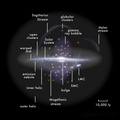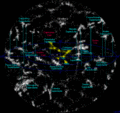Location of Earth
Location of the Earth in the Universe From Wikipedia, the free encyclopedia
Knowledge of the location of Earth has been shaped by 400 years of telescopic observations, and has expanded radically since the start of the 20th century. Initially, Earth was believed to be the center of the Universe, which consisted only of those planets visible with the naked eye and an outlying sphere of fixed stars.[1] After the acceptance of the heliocentric model in the 17th century, observations by William Herschel and others showed that the Sun lay within a vast, disc-shaped galaxy of stars.[2] By the 20th century, observations of spiral nebulae revealed that the Milky Way galaxy was one of billions in an expanding universe,[3][4] grouped into clusters and superclusters. By the end of the 20th century, the overall structure of the visible universe was becoming clearer, with superclusters forming into a vast web of filaments and voids.[5] Superclusters, filaments and voids are the largest coherent structures in the Universe that we can observe.[6] At still larger scales (over 1000 megaparsecs[a]) the Universe becomes homogeneous, meaning that all its parts have on average the same density, composition and structure.[7]
Logarithmic representation of the universe centered on the Solar System. Celestial bodies on this graphic are clickable and shown with their sizes enlarged. |
Since there is believed to be no "center" or "edge" of the Universe, there is no particular reference point with which to plot the overall location of the Earth in the universe.[8] Because the observable universe is defined as that region of the Universe visible to terrestrial observers, Earth is, because of the constancy of the speed of light, the center of Earth's observable universe. Reference can be made to the Earth's position with respect to specific structures, which exist at various scales. It is still undetermined whether the Universe is infinite. There have been numerous hypotheses that the known universe may be only one such example within a higher multiverse; however, no direct evidence of any sort of multiverse has been observed, and some have argued that the hypothesis is not falsifiable.[9][10]
Details
Earth is the third planet from the Sun with an approximate distance of 149.6 million kilometres (93.0 million miles), and is traveling nearly 2.1 million kilometres per hour (1.3 million miles per hour) through outer space.[11]
Table
| Feature | Diameter | Notes | Sources | |
|---|---|---|---|---|
| (most suitable unit) | (km, with scientific notation) | |||
| Earth | 12,756.2 km (equatorial) |
1.28×104 | Measurement comprises just the solid part of the Earth; there is no agreed upper boundary for Earth's atmosphere. The geocorona, a layer of UV-luminescent hydrogen atoms, lies at 100,000 km. The Kármán line, defined as the boundary of space for astronautics, lies at 100 km. | [12][13][14][15] |
| Orbit of the Moon | 768,210 km[b] | 7.68×105 | The average diameter of the orbit of the Moon relative to the Earth. | [16] |
| Geospace | 6,363,000–12,663,000 km (110–210 Earth radii) |
6.36×106–1.27×107 | The space dominated by Earth's magnetic field and its magnetotail, shaped by the solar wind. | [17] |
| Earth's orbit | 299.2 million km[b] 2 AU[c] |
2.99×108 | The average diameter of the orbit of the Earth relative to the Sun. Encompasses the Sun, Mercury and Venus. | [18] |
| Inner Solar System | ~6.54 AU | 9.78×108 | Encompasses the Sun, the inner planets (Mercury, Venus, Earth, Mars) and the asteroid belt. Cited distance is the 2:1 resonance with Jupiter, which marks the outer limit of the asteroid belt. | [19][20][21] |
| Outer Solar System | 60.14 AU | 9.00×109 | Includes the outer planets (Jupiter, Saturn, Uranus, Neptune). Cited distance is the orbital diameter of Neptune. | [22] |
| Kuiper belt | ~96 AU | 1.44×1010 | Belt of icy objects surrounding the outer Solar System. Encompasses the dwarf planets Pluto, Haumea and Makemake. Cited distance is the 2:1 resonance with Neptune, generally regarded as the outer edge of the main Kuiper belt. | [23] |
| Heliosphere | 160 AU | 2.39×1010 | Maximum extent of the solar wind and the interplanetary medium. | [24][25] |
| Scattered disc | 195.3 AU | 2.92×1010 | Region of sparsely scattered icy objects surrounding the Kuiper belt. Encompasses the dwarf planet Eris. Cited distance is derived by doubling the aphelion of Eris, the farthest known scattered disc object. As of now, Eris's aphelion marks the farthest known point in the scattered disc. | [26] |
| Oort cloud | 100,000–200,000 AU 0.613–1.23 pc[a] |
1.89×1013–3.80×1013 | Spherical shell of over a trillion (1012) comets. Existence is currently hypothetical, but inferred from the orbits of long-period comets. | [27] |
| Solar System | 1.23 pc | 3.80×1013 | The Sun and its planetary system. Cited diameter is that of the Sun's Hill sphere; the region of its gravitational influence. | [28] |
| Local Interstellar Cloud | 9.2 pc | 2.84×1014 | Interstellar cloud of gas through which the Sun and a number of other stars are currently travelling. | [29] |
| Local Bubble | 2.82–250 pc | 8.70×1013–7.71×1015 | Cavity in the interstellar medium in which the Sun and a number of other stars are currently travelling. Caused by a past supernova. | [30][31] |
| Gould Belt | 1,000 pc | 3.09×1016 | Projection effect of the Radcliffe wave and Split linear structures (Gould Belt),[32] between which the Sun is currently travelling. | [33] |
| Orion Arm | 3000 pc (length) |
9.26×1016 | The spiral arm of the Milky Way Galaxy through which the Sun is currently travelling. | |
| Orbit of the Solar System | 17,200 pc | 5.31×1017 | The average diameter of the orbit of the Solar System relative to the Galactic Center. The Sun's orbital radius is roughly 8,600 parsecs, or slightly over halfway to the galactic edge. One orbital period of the Solar System lasts between 225 and 250 million years. | [34][35] |
| Milky Way Galaxy | 30,000 pc | 9.26×1017 | Our home galaxy, composed of 200 billion to 400 billion stars and filled with the interstellar medium. | [36][37] |
| Milky Way subgroup | 840,500 pc | 2.59×1019 | The Milky Way and those satellite dwarf galaxies gravitationally bound to it. Examples include the Sagittarius Dwarf, the Ursa Minor Dwarf and the Canis Major Dwarf. Cited distance is the orbital diameter of the Leo T Dwarf galaxy, the most distant galaxy in the Milky Way subgroup. Currently 59 satellite galaxies are part of the subgroup. | [38] |
| Local Group | 3 Mpc[a] | 9.26×1019 | Group of at least 80 galaxies of which the Milky Way is a part. Dominated by Andromeda (the largest), the Milky Way and Triangulum; the remainder are dwarf galaxies. | [39] |
| Local Sheet | 7 Mpc | 2.16×1020 | Group of galaxies including the Local Group moving at the same relative velocity towards the Virgo Cluster and away from the Local Void. | [40][41] |
| Virgo Supercluster | 30 Mpc | 9.26×1020 | The supercluster of which the Local Group is a part. It comprises roughly 100 galaxy groups and clusters, centred on the Virgo Cluster. The Local Group is located on the outer edge of the Virgo Supercluster. | [42][43] |
| Laniakea Supercluster | 160 Mpc | 4.94×1021 | A group connected with the superclusters of which the Local Group is a part. Comprises roughly 300 to 500 galaxy groups and clusters, centred on the Great Attractor in the Hydra–Centaurus Supercluster. | [44][45][46][47] |
| Pisces–Cetus Supercluster Complex | 330 Mpc | 1×1022 | Galaxy filament that includes the Pisces-Cetus Superclusters, Perseus–Pisces Supercluster, Sculptor Supercluster and associated smaller filamentary chains. | [48][49] |
| Observable Universe | 28,500 Mpc | 8.79×1023 | At least 2 trillion galaxies in the observable universe, arranged in millions of superclusters, galactic filaments, and voids, creating a foam-like superstructure. | [50][51][52][53] |
| Universe | ≥28,500 Mpc (possibly infinite) |
≥8.79×1023 | Beyond the observable universe lie the unobservable regions from which no light has yet reached the Earth. No information is available, as light is the fastest travelling medium of information. However, uniformitarianism argues that the Universe is likely to contain more galaxies in the same foam-like superstructure. | [54] |
Gallery
Location of Earth in the Universe
Local Interstellar Cloud and neighbouring interstellar medium
Star associations and interstellar medium map of the Local Bubble
Molecular clouds around the Sun inside the Orion-Cygnus Arm
Orion-Cygnus Arm inside the Milky Way
Laniakea SCl in Pisces–Cetus Supercluster Complex
Observable Universe of the Universe

 Clickable image of the Location of Earth. Place your mouse cursor over an area in the image to see the related area name; click to link to an article about the area.
Clickable image of the Location of Earth. Place your mouse cursor over an area in the image to see the related area name; click to link to an article about the area. 
See also
Notes
- A parsec (pc) is the distance at which a star's parallax as viewed from Earth is equal to one second of arc, equal to roughly 206,000 AU or 3.0857×1013 km. One megaparsec (Mpc) is equivalent to one million parsecs.
- 1 AU or astronomical unit is the distance between the Earth and the Sun, or 150 million km. Earth's orbital diameter is twice its orbital radius, or 2 AU.
References
Wikiwand - on
Seamless Wikipedia browsing. On steroids.




















